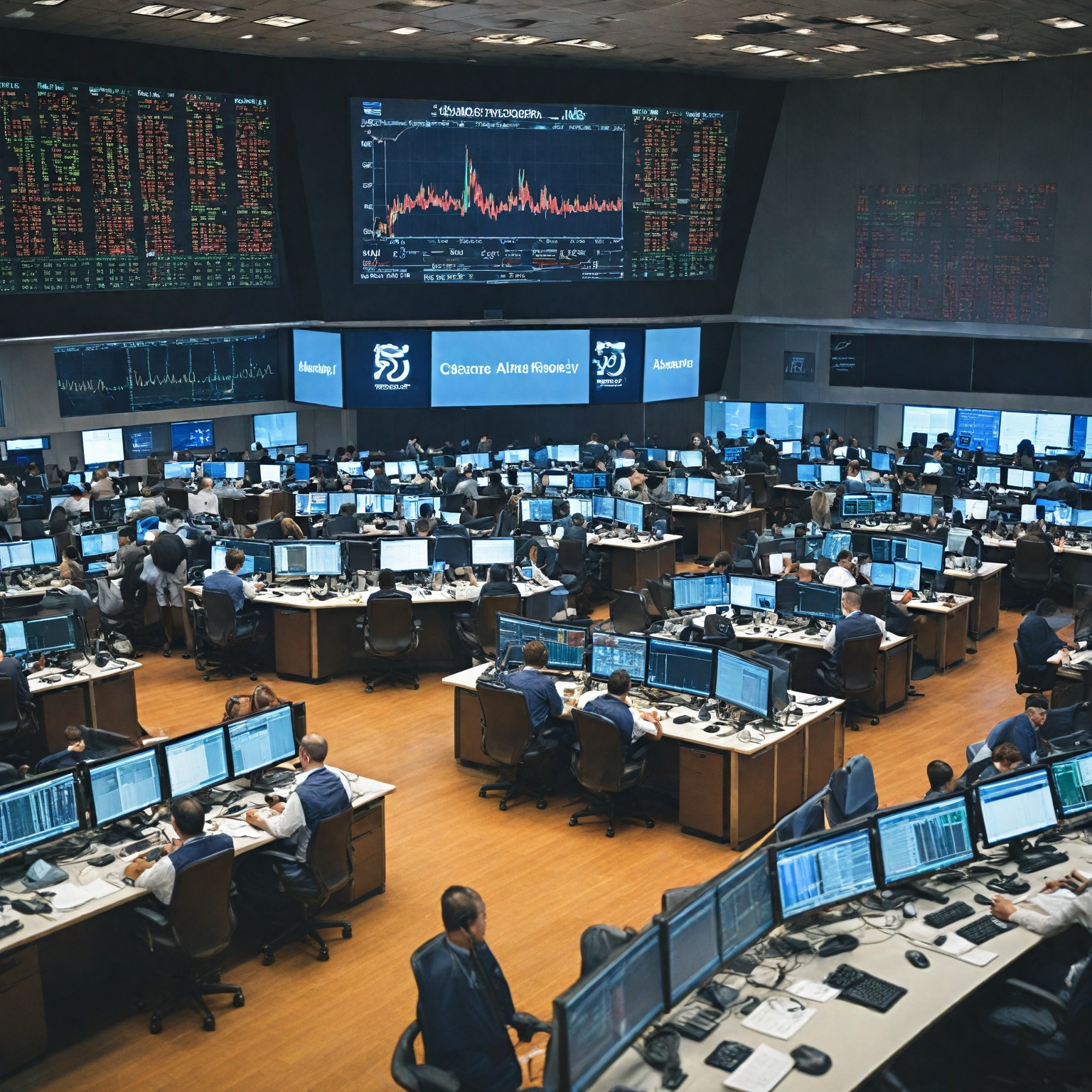Summary
The S&P 500 recently closed at yet another record high, marking a continuation of a notable momentum in the U.S. stock market that has seen the index achieve new highs on 70 trading days this year, the second highest on record. This sustained performance has attracted widespread attention from investors and financial analysts who closely monitor related stock futures to gauge market expectations for upcoming trading sessions. Stock futures—legally binding contracts based on the future value of major indexes like the S&P 500, Nasdaq Composite, and Dow Jones Industrial Average—serve as critical tools for hedging and speculation, providing real-time insights into investor sentiment.
Following the latest record close, futures tied to these indexes showed relatively muted activity during after-hours trading, with slight declines in S&P 500 futures and largely flat movements in Nasdaq futures, reflecting cautious market positioning despite strong underlying fundamentals. This restrained reaction underscores the complex interplay of factors shaping market dynamics, including robust corporate earnings reports—where over 85% of S&P 500 companies have beaten analyst expectations this quarter—and ongoing geopolitical tensions that inject uncertainty and occasional volatility into trading patterns.
The market’s current state is further influenced by the scheduled rebalancing and reconstitution of major indexes, events that often trigger increased trading volumes and price fluctuations as index-tracking funds adjust their portfolios. These rebalancing activities contribute to trading costs and can affect short-term market behavior, highlighting the importance for investors to understand the implications of such structural market changes. Additionally, macroeconomic indicators and market sentiment measures, including volatility indexes and put-to-call ratios, continue to shape futures pricing by reflecting broader economic conditions and investor psychology.
As live updates on stock futures become increasingly accessible through advanced digital platforms and real-time data feeds, investors and traders can respond swiftly to evolving market conditions. Nevertheless, the outlook remains tempered by economic growth concerns—such as the IMF’s recent downgrade of U.S. GDP forecasts—and geopolitical risks that have historically led to temporary declines in stock valuations. This environment of sustained record highs combined with underlying uncertainties underscores the significance of stock futures as a barometer for market direction and risk management in today’s complex financial landscape.
Background
Stock futures are legally binding contracts between buyers and sellers that allow trading on the future value of financial indexes, such as the S&P 500, Nasdaq Composite, and Dow Jones Industrial Average. These derivative contracts enable investors to hedge or speculate on the price movements of the underlying indexes by agreeing to buy or sell at a predetermined price on a future date. Because futures contracts track the prices of the underlying assets, index futures reflect expected market movements and are closely monitored by both investors and financial media as indicators of market sentiment.
Historically, the dissemination of market information and social exchanges evolved from slow, traditional methods such as letters and print media to the accelerated communication enabled by radio and television. This progression laid the groundwork for the instant and continuous updates that characterize today’s financial markets, including real-time futures data and after-hours trading coverage.
Recent activity in stock futures often correlates with the performance of the associated indexes during regular trading hours. For example, following record closes of the S&P 500 and Nasdaq Composite, futures tied to these indexes have shown minimal change or slight fluctuations in after-hours trading. These movements provide insight into investor expectations for the market’s direction ahead of the next trading session.
Understanding how futures operate and their role in market dynamics is crucial for investors, as these instruments can influence portfolio strategies and risk management practices. Additionally, the costs associated with index investing encompass not only portfolio design and management but also trading-related factors, such as price pressure and volume shifts during index reconstitutions, which can impact futures trading and overall market behavior.
Recent Trends in the S&P 500
In the latest reporting period, over 60 companies within the S&P 500 have disclosed their earnings, with more than 85% surpassing analysts’ expectations according to FactSet data. Market participants are closely monitoring corporate commentary for insights into macroeconomic stability, tariff impacts, and spending related to artificial intelligence, which are key factors influencing investor sentiment.
The S&P 500 index has experienced notable momentum, closing at new record highs on 70 out of the 252 trading days in the year. This achievement marks the second-highest number of record closes in a single year, surpassed only by the 77 records set in 1995. Additionally, 2021 was significant as the S&P 500 outperformed the Dow Jones Industrial Average and the Nasdaq Composite for the first time since 2005.
These trends reflect a dynamic market environment where corporate earnings, economic indicators, and technological investment all play crucial roles in shaping the index’s performance.
Live Updates on Stock Futures Following the Latest Record Close
Following the S&P 500 and Nasdaq Composite hitting fresh record highs, stock futures showed little change in after-hours trading. Futures tied to the S&P 500 were marginally lower, while Nasdaq 100 futures also remained largely flat, indicating a cautious market sentiment despite the record closes. Similarly, futures linked to the Dow Jones Industrial Average experienced a slight uptick, climbing approximately 53 points or 0.1% shortly after 6 p.m. ET, with S&P 500 and Nasdaq 100 futures opening just above the flatline.
Investors closely monitor futures tied to major indexes such as the S&P 500 because these contracts provide a real-time indicator of market expectations for the next trading day. S&P 500 futures, including E-mini and micro E-mini contracts, enable traders to hedge or speculate on the index’s future value through legally binding agreements to buy or sell at a specified date. The value of these contracts correlates directly with the index level, making them a crucial tool for gauging market direction and investor sentiment.
Market movements in futures often reflect broader economic and geopolitical factors, though immediate futures reactions tend to be muted following record index closes. For example, geopolitical tensions or significant events can trigger initial volatility, but longer-term market performance is usually shaped by fundamentals such as corporate earnings and interest rates. This dynamic was observed when geopolitical events led to early trading declines and increased oil prices, yet futures trading soon stabilized as investors assessed the broader implications.
Factors Influencing Current Stock Futures Movements
Stock futures movements are influenced by a combination of company-specific events, broader economic indicators, geopolitical developments, and market sentiment. After the S&P 500 and Nasdaq Composite hit fresh record highs, futures tied to these indexes showed little change, reflecting a cautious market poised between optimism and uncertainty.
Earnings Reports and Corporate Performance
One of the primary drivers of stock futures is corporate earnings reports. These quarterly disclosures provide investors with insights into a company’s profitability and financial stability over the preceding three months. Earnings results that significantly exceed or fall short of expectations—known as earnings surprises—can cause immediate fluctuations in stock prices. For instance, a company beating earnings estimates may see its stock price rise, whereas disappointing earnings often result in declines. However, even positive earnings can lead to stock price drops if management issues a negative outlook or fails to provide forward guidance, highlighting the importance of future expectations alongside current performance. Earnings per share (EPS) is a critical metric within this context, serving as a key indicator of profitability that investors closely monitor.
Macroeconomic Indicators and Market Sentiment
Beyond individual companies, macroeconomic variables such as gross domestic product (GDP), inflation rates, unemployment figures, and retail sales significantly influence stock futures. These indicators provide a snapshot of economic health and potential future growth, affecting broader market sentiment and, in turn, the valuation of individual stocks. For example, slower projected economic growth or rising inflation can temper investor enthusiasm, leading to more subdued futures movements. The International Monetary Fund’s recent downward revision of U.S. growth forecasts to 1.8% for 2025 illustrates how macroeconomic uncertainty can weigh on market expectations.
Investor sentiment itself, often driven by behavioral factors and crowd psychology, plays a critical role in short-term price dynamics. Market sentiment measures, including the widely followed CBOE Volatility Index (VIX) and the Fear & Greed Index, help gauge the prevailing mood among investors. A rising put-to-call ratio and increased volatility readings generally indicate nervousness or bearishness in the market, which can suppress futures gains even in the absence of fundamental changes.
Geopolitical Events and Global Risks
Geopolitical developments remain another significant factor influencing stock futures. Although large, globally diversified equity markets may show resilience over the long term, local market volatility can spike in response to geopolitical shocks such as military conflicts, trade disputes, or political instability. Historical analyses of over 80 years of geopolitical events reveal that international conflicts often lead to short- to medium-term declines in stock valuations, with an average drop of approximately 2.5% following the involvement of a major trading partner in military actions. Recent regional tensions and surprise military actions have caused immediate market reactions, including index declines and surges in commodity prices such as oil, reflecting concerns over economic disruption and energy supply.
Market Dynamics Post-Record Close
Following the S&P 500’s latest record close, the market dynamics have reflected a complex interplay of factors influencing investor behavior and trading patterns. The index itself closed at new record levels on 70 of the year’s 252 trading days, marking the second highest frequency of record closes, behind only 1995. This environment of sustained highs has generated heightened interest in futures markets, with U.S. stock futures showing marginal fluctuations shortly after the close, indicating cautious positioning ahead of key earnings announcements from major S&P 500 companies.
Market participants have been navigating increased volatility triggered by geopolitical events, such as surprise military actions in the Middle East, which have led to early trading declines across major indexes and spikes in oil prices due to concerns over energy supply disruptions. These geopolitical tensions contribute to uncertainty in economic partnerships and international relations, amplifying market fluctuations and investor risk assessments.
Another driver of post-record market dynamics is the anticipated rebalancing and reconstitution of index constituents. When indices like the S&P 500 announce changes to their constituent stocks, a surge in trading volume often follows as funds and ETFs adjust their holdings to mirror the updated index composition. This forced trading can create short-term volatility and cost implications for index-tracking funds, which might be mitigated by spreading turnover over multiple trading days rather than concentrating activity on a single day.
Liquidity considerations also play a critical role in shaping market responses. Assets with higher liquidity, such as those represented in major stock indices, allow for quicker conversion to cash with minimal price impact, thus supporting smoother trading even amid volatility. Conversely, less liquid assets may experience greater price disruptions during periods of rapid market shifts.
Impact of Index Rebalancing and Constituent Changes
Index rebalancing is primarily undertaken to ensure that an index accurately reflects its investment objective and remains relevant over time. This process involves adjusting the weights of the index’s components and may include adding or removing securities to maintain alignment with the index’s mandate. Since companies within an index can experience changes in value or business focus, failing to rebalance can lead to disproportionate weightings that distort the index’s intended exposure.
The rebalancing and reconstitution of major indexes, such as the S&P 500, are highly anticipated events in the financial markets. When announcements are made about additions or deletions of index constituents, they often trigger a wave of speculative and opportunistic trading. Index-tracking funds, including mutual funds and ETFs that aim to replicate the index, are compelled to adjust their portfolios accordingly. This leads to a surge in trading volume and forced transactions on the day the changes take effect, which can have significant short-term impacts on stock prices and sector trends.
From an investor’s perspective, these trading activities generate various costs associated with index investing. These include portfolio design inefficiencies, such as overlooking differences in expected returns across securities, and portfolio management challenges, including style drift due to infrequent rebalancing. Of particular note are the trading costs incurred during index reconstitution events. Research indicates that the demand for immediacy in trading during these times can elevate transaction costs. A more efficient strategy might involve distributing turnover over multiple trading days to minimize price pressure and focus on securities with higher expected returns.
Implications for Investors and Traders
Investors and traders face a range of considerations related to index investing and market dynamics, particularly concerning trading costs, rebalancing, and market sentiment. The costs associated with index investing can be broadly categorized into portfolio design, portfolio management, and trading, with trading costs—including those arising from index reconstitution—receiving significant focus due to their immediate impact on market behavior.
Rebalancing events, which occur when index compositions are adjusted, can trigger substantial trading volumes and price fluctuations. These shifts not only affect stock prices and sector trends but also influence broader market sentiment. For investors holding index-tracking mutual funds or exchange-traded funds (ETFs), rebalancing can prompt portfolio adjustments and create new investment opportunities, as well as tax consequences. The impact of rebalancing varies depending on the index type, such as market cap-weighted or equal-weighted indexes, and investors are advised to monitor such events to adapt their strategies accordingly.
The process of index reconstitution is particularly notable in the case of major indexes like the S&P 500. Announcements of constituent changes often lead to speculative positioning by some investors prior to the official adjustments. On the day of reconstitution, ETFs and funds replicating the index face a surge of forced trading to realign with the new index composition, which can create significant volume and price pressure in the affected securities.
Market volatility also plays a critical role in investor behavior and sentiment. Geopolitical events, such as unexpected conflicts or elections, can disrupt economic outlooks and lead to heightened market uncertainty, as seen in recent declines following geopolitical tensions in key regions for global energy. Volatility measures, including the CBOE Volatility Index (VIX), serve as important gauges of market sentiment by reflecting expected price fluctuations. Rising ratios of bearish options activity typically signal increased investor nervousness, often preceding market downturns.
For traders, index futures contracts—such as those based on the S&P 500—offer tools for speculation and hedging by allowing positions to be taken on the future value of the index. These derivatives are closely monitored as indicators of market expectations and sentiment. While standard-sized S&P 500 futures contracts have been delisted, E-mini futures continue to provide similar functionality for investors seeking to hedge risk or speculate on price movements.
Technology and Platforms for Live Futures Market Updates
Live futures market updates are primarily facilitated through advanced streaming technologies and specialized platforms that provide real-time data directly from exchanges like the CME Group. These platforms offer investors and traders cost-efficient access to live futures and options market data, enabling them to query, analyze, and share information seamlessly.
The continuous stream of live data includes key derivative contracts such as S&P 500 futures, which reflect market expectations of the S&P 500 Index’s future value. Access to this real-time data is essential for investors looking to hedge or speculate, as it allows them to respond promptly to market movements and make informed decisions.
Platforms providing live futures data typically integrate sophisticated APIs and user-friendly interfaces designed to handle large volumes of market data efficiently. These technological solutions ensure that both individual investors and financial professionals can monitor market trends and adjust their strategies in near real-time.
Furthermore, these platforms support various professional users, including economists and financial analysts, who rely on timely market data to forecast economic trends, evaluate financial flows, and interpret macroeconomic indicators that influence market sentiment and asset prices.
Future Outlook
The outlook for the stock market, particularly following another record close of the S&P 500, remains influenced by a variety of economic and geopolitical factors. One key aspect investors are closely monitoring is the scheduled reconstitution and rebalancing of major indexes like the S&P 500. Such events lead to significant trading activity, as index-tracking funds and ETFs adjust their portfolios to align with the updated constituents, potentially causing increased volatility and trading costs.
Economic forecasts also weigh heavily on future market performance. The International Monetary Fund has recently downgraded its U.S. economic growth forecast to 1.8% for 2025, largely due to heightened tariffs and ongoing trade tensions that have reached century highs. This slowdown in growth projections comes

























